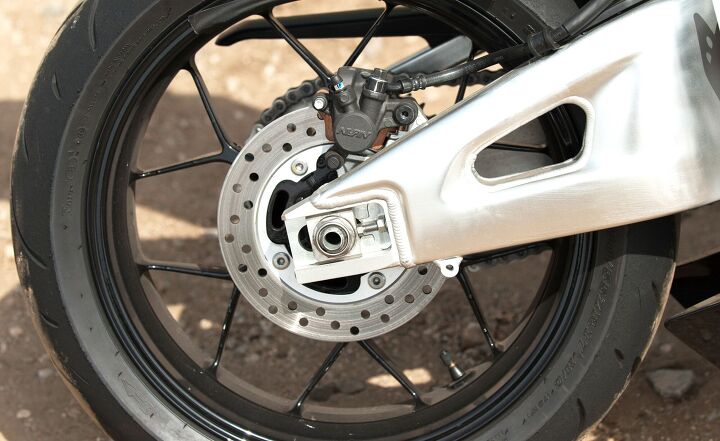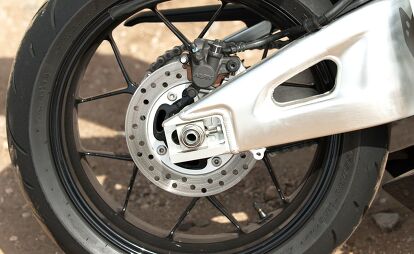Lessons From A MOron: How To Use The Rear Brake

It's there. You should use it.
The rear brake is probably one of the most taboo subjects in motorcycling, second only to the black art that is motorcycle suspension. The truth is neither subject has to be any more intimidating than you make it to be, and the rear brake is actually very useful. Granted, the front brake(s) carry the majority of the workload when it comes to slowing down and stopping, but knowing how to use the rear brake effectively will serve you better when it comes to bike control rather than simply scrubbing speed.
Here we’ll explain some of the ways you can use the rear brake to make you a better rider. From settling the chassis to corner corrections and even as a poor man’s wheelie control, we encourage you, after reading this, to try some of these techniques to see if they work for you.
First up, settling the chassis.
Chassis Control
We all know to use the front brake to slow down, especially at high speeds, but before you reach for the front lever, try using the rear brake first. Here’s why: when you reach for the front brake, the motorcycle will pitch forward quickly and can make it difficult to apply any other input (like steering inputs) until the chassis settles down. The technique here is to apply a little rear brake a fraction of a second before you apply the front brake. Dabbing the rear first will make the back of the bike squat a tiny bit, so when you apply the front the whole bike will squat a little more evenly. The front won’t pitch forward as quickly and the whole bike will feel more settled.
The important thing to remember is the nearly imperceptible difference between applying the rear and then the front. Also, unlike the front, you don’t need to keep the rear applied for the entire braking zone. The rear is much more difficult to modulate compared to the front, and you risk locking the rear if you keep it applied for too long while your speeds come down. Unless you have ABS, which is a game-changer.
Corner Corrections
Instead of thinking of the rear brake as a speed reducer, we can also start thinking of it as a line corrector. If you’re running wide in a turn or corner, chopping the throttle and/or applying the front brake can upset the chassis. In an extreme case, it could tuck the front. If all you need is a minor line correction – say, to tighten the corner and get the front pointed where you want to go – using the rear brake can help. Depending on the amount you need to correct your line, you may not even need to release the throttle.
Using the rear brake, in this case, makes the rear act as a pivot point as the rest of the motorcycle rotates around that axis; moving the nose down even a smidge steepens rake, reduces trail, and encourages the bike to turn. Try it in a big parking lot or corner you know very well. Intentionally run a tiny bit wide then use the rear brake to tighten your line.
U-Turns
Let’s take the tight turn example to the extreme – U-turns. Executing a tight, 180º turn is difficult, even for seasoned veterans on little motorcycles. Doing one on, say, a Honda Goldwing, ups the ante quite a bit. That said, you can still use the rear brake to tighten your turning radius.
For U-turns, keep your speed fast enough to have momentum. If you can (it may not be so easy on cruisers), sit on the outside of the seat as you initiate the U-turn, keep the throttle steady, slip the clutch if needed, and drag the rear brake to tighten your turn.
This is easier to do on left turns rather than rights because of the position of the brake lever, but it’s still doable.
With A Passenger
As we know, the rear brake’s less effective because there isn’t much weight on the rear tire when you’re slowing down. So, what if you put weight on the rear in the form of a passenger? Suddenly, the rear brake is more effective. If you don’t have ABS, just remember that there’s a fine line between getting more out of your rear brake and over-using it.
Wheelie Control
A wheelie you didn’t plan for or expect can be a scary thing, especially if you aren’t very good at wheelies in the first place, like Yours Truly. This is one of the (many) reasons modern sportbikes have electronics suites that include wheelie control as part of the package. The other reason is because when power is being used to move the front wheel up instead of forward, you’re losing time. And in the case of sportbikes, anyway, those precious tenths of seconds mean something.
There’s an obvious problem, of course: What if you don’t have fancy electronics on your bike? Never fear – you have the rear brake. Experienced stunt riders know to cover the rear brake in case they need it to bring a wheelie back in check. This is a technique the rest of us can borrow, too. Whether on the street or on the track, being ready with the rear brake in case a wheelie pops its head unexpectedly could be the difference between a successful ride or a looped motorcycle.
For a real-world case study, take Turn 1 at Laguna Seca. You enter this high-speed left-hander just as you cross the start/finish line, and its apex crests a little hill, causing the front to come off the ground (and if you’re Marc Marquez, both wheels get air underneath them momentarily). Ask the top-level racers, and at least one will tell you, even with the electronics, they jam the rear brake over the hill while keeping the throttle pinned. Yes, full throttle and right foot (or left thumb/finger) firmly on the lever to keep the wheel either on the ground or close to it.
Don’t Write Off The Right Lever
Hopefully, this has expanded your horizons as far as rear brakes are concerned. Truth be told, there are still many more uses for the rear brake we didn’t cover here – like how to use it off-road – but that’s a topic for another time, written by someone more qualified. For road riders who have always wondered why they should use the rear brake, these are just a few examples you can think about when you ride.
As always when it comes to learning new techniques, work slowly and practice in big spaces or roads you’re intimately familiar with.

Troy's been riding motorcycles and writing about them since 2006, getting his start at Rider Magazine. From there, he moved to Sport Rider Magazine before finally landing at Motorcycle.com in 2011. A lifelong gearhead who didn't fully immerse himself in motorcycles until his teenage years, Troy's interests have always been in technology, performance, and going fast. Naturally, racing was the perfect avenue to combine all three. Troy has been racing nearly as long as he's been riding and has competed at the AMA national level. He's also won multiple club races throughout the country, culminating in a Utah Sport Bike Association championship in 2011. He has been invited as a guest instructor for the Yamaha Champions Riding School, and when he's not out riding, he's either wrenching on bikes or watching MotoGP.
More by Troy Siahaan







































Comments
Join the conversation
Rear brake is the secret sauce of power modulation.
You don't have the right to say "modern bikes have too much electronic nannies" until you've earned it by mastering both front and rear brakes.
Another good use of the rear brake is to use it to skid to stop in front of someone you want to impress. The longer the skid mark, the better. Seriously though, I have a BMW R1200RT with servo linked brakes and don't know which brakes are being applied at what time. I think the back brake lever only uses the rear wheel brake.